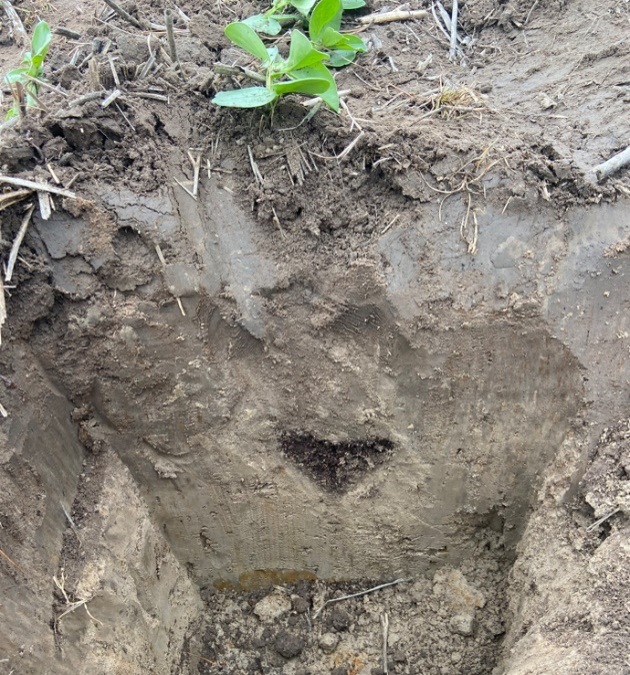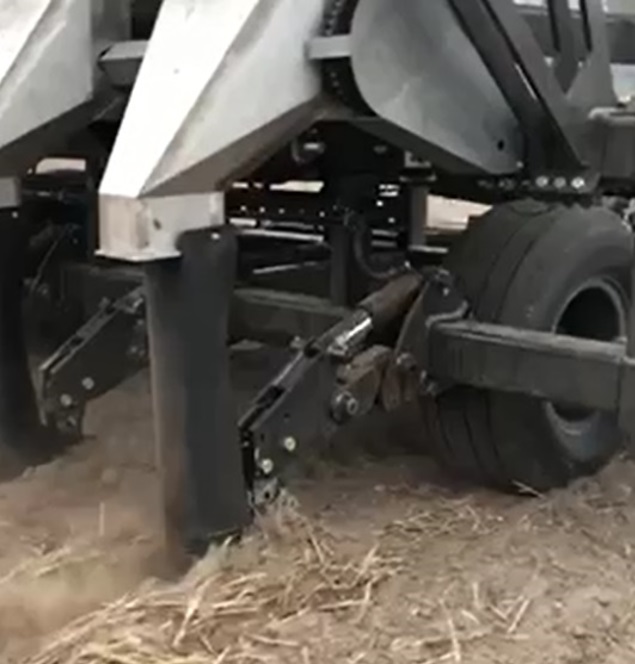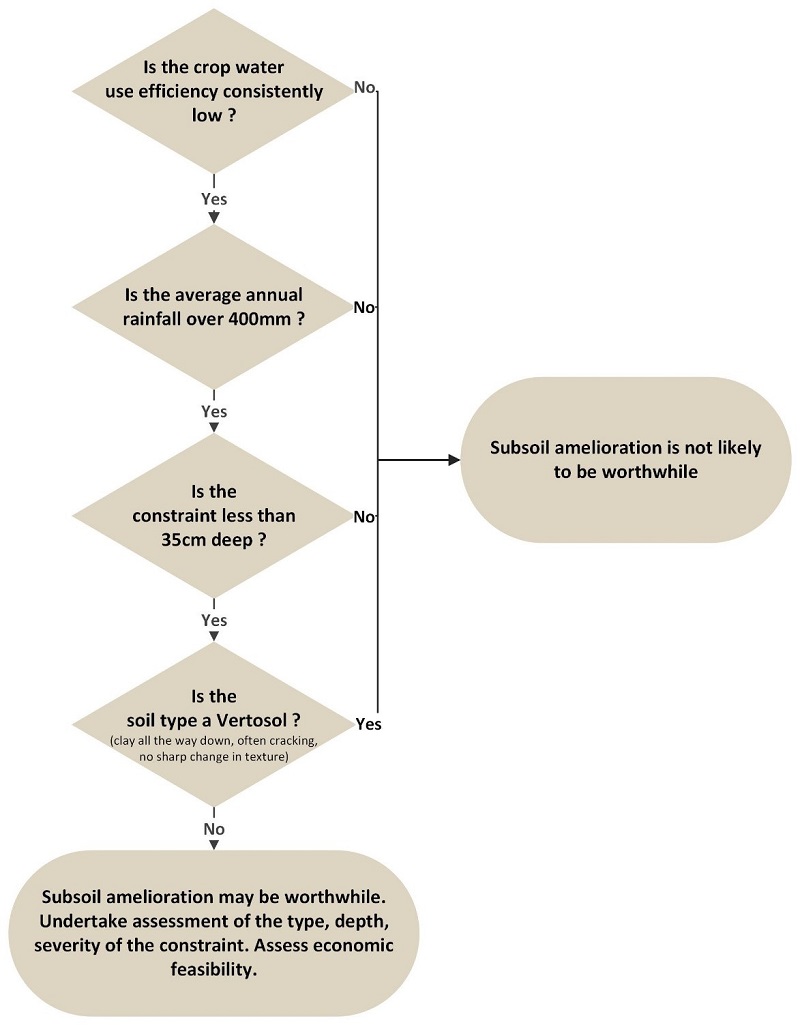Decision support for grain growers
Subsoil amelioration in medium and high rainfall zones
Key points
- Many Australian soils used for growing grain crops contain a range of subsoil constraints, which can restrict root growth and grain yields. These include high sodium (sodicity), salinity and high soil strength.
- Subsoil amelioration is where amendments, such as animal manures or plant residues, are placed into subsoils to help mitigate soil constraints.
- Implementing subsoil amelioration can be expensive, with ‘upfront’ costs approximately $1,500 - $2,500 per hectare. Growers need to be confident that subsoil amelioration will produce sufficient yield benefits to offset the investment.
- Yield responses to subsoil amelioration average an increase of 10 - 15% with benefits lasting for several years.
- To decide if and where subsoil amelioration should be undertaken, it is important to know how soil properties vary within a paddock.
This decision support guide seeks to help dryland grain growers, in the medium and high rainfall zones of Victoria, decide if subsoil amelioration is likely to be profitable. The guide focuses on subsoil amelioration using organic matter, particularly in clay subsoils.
What is subsoil amelioration?
Subsoil amelioration involves placing amendments into the soil at-depth to overcome constraints that reduce root growth and function – to improve grain yields. Subsoil amelioration can produce improvements in soil function for at least 5 years.
Amendments used in subsoil amelioration can include animal manure, plant material or inorganic amendments, such as lime, gypsum or fertiliser. Amelioration can be achieved by deep ripping or mixing soil. Yield responses heavily depend on the rainfall and soil properties.
Grain yield responses to subsoil amelioration
In a series of subsoil amelioration trials, covering a range of soil types and rainfall zones in south-eastern Australia, grain yields increased by an average 12%. The yield responses, however, varied widely between sites, from negative in some cases to 65%. Yield responses were less likely in soils with few constraints or in very dry or very wet seasons.
Locations with consistent yield improvements saw benefits persisting for at least 5 years. Subsoil amelioration, particularly with animal manures, often enhances crop dry matter but does not always increase grain yield.
How subsoil amelioration is undertaken with organic materials
Ideally, large amounts of organic matter – 10 to 20 tonnes per hectare (t/ha) – are placed where the soil constraints start to limit root growth.
Placing organic matter where the subsoil constraint starts improves water and air movement through the soil, which in turn improves root growth and uptake of water and nutrients. With time, soil structure improves in an increasing radius around the organic amendment.
Subsoil amelioration is generally done with specially adapted deep tillage machines. These place large quantities of amendment into the subsoil while minimising subsoil coming to the surface. Commonly, this is achieved by using a wingless deep ripper shank with a narrow chisel tip attached.
A large flexible boot reduces bridging and guides the organic matter – using gravity – immediately behind the shank. This is followed by closers such as press wheels. The operation leaves a ‘sausage’ of organic matter in the top of the subsoil constraint.


Figure 1 shows on left amendment placed into the top of heavy sodic clay subsoil and on the right a subsoil amelioration machine with hydraulic breakouts in operation.
Soil moisture and soil texture influence the success of subsoil amelioration, as:
- subsoil amelioration is easier in sandy topsoils
- if clay soils are too wet, clay is smeared
- if soils are too dry and large blocks of clay are brought to the surface soil, the next crop can have poorer establishment.
Subsoil amelioration improves soil
The main benefits of subsoil amelioration are better nutrition in the short-term and improved soil structure in the long-term.
Subsoil amelioration effectively increases the size of the ‘soil water bucket’ available to crops.
This is achieved by:
- greater root growth via reduced soil strength
- improved soil aggregation in dispersive soils and increased aeration in waterlogged soils.
better infiltration of rainfall - increased nutrient supply (especially phosphorus, nitrogen, potassium and sulfur).


Figure 2 shows comparison between untreated (left) and treated (right) subsoil 4 years after treatment. The subsoil was ameliorated with lucerne pellets and animal manure.
An additional benefit of subsoil amelioration is that most amendments provide a significant source of nutrients - especially phosphorus, nitrogen, potassium and sulphur - which can reduce fertiliser requirements.
When to consider subsoil amelioration
Consistently poor performing paddocks, or sections of paddocks, that have had good fertiliser and disease management should be investigated for subsoil problems. These areas can often be picked up in yield maps and satellite NDVI maps.

Figure 3 shows a decision support guide to the likelihood of successful subsoil amelioration.
If the crop performance is well below the water-limited yield potential, this is a clear sign that the crop is not using deeper stored soil moisture. Note that yield benefits from amelioration are limited by water availability.
Improving subsoil conditions might be beneficial where crops are losing at least:
- 10% of potential yield in high rainfall areas, or
- 20% of potential yield in medium rainfall areas, due to subsoil constraints.
Subsoil amelioration could be trialled if the targeted soil constraints are in the top 15 - 35 cm. The critical depth will vary with the type of machinery available, soil texture and soil moisture at the time of amelioration.
Subsoil amelioration: balancing costs with benefits
For subsoil amelioration to be most cost-effective, it needs optimal climatic conditions in the season following amelioration. This ‘activates’ the organic matter so that soil properties are improved. It also enables the crop to best exploit nutrients contained in the amendment.
Even after implementing subsoil amelioration, yield potential is limited by water availability - so the cost needs to be balanced against the potential yield gap. In medium rainfall areas where wheat yields have the potential to average 3.5 - 4.5 t/ha, the yield gap is less and may not be a worthwhile investment compared with high rainfall areas where yield potentials can be greater than 10 t/ha.
Research indicates that it can take 3 years to pay-back the initial investment at sites with moderate to good yield responses.
Costs vary between $1,500 to $2,500 per hectare depending on the:
- source and transport distance of the organic matter.
- hire or ownership of machinery.
- depth of constraint - which impacts fuel and time.
- rate of organic matter used.
The potential water-limited yield gap needs to be large enough to ensure this investment is worthwhile.
Type of constraints in which subsoil amelioration may be effective
Most subsoils have multiple constraints present, often at the same depth. While subsoil amelioration can mitigate many subsoil constraints - such as waterlogging, sodicity and compaction - it is not effective in very alkaline, very acidic or very saline soils.
Most soil types are responsive to subsoil amelioration, except for ‘vertosols’. Vertosols have heavy clay throughout, usually cracking or swelling and no distinct changes or layers with depth. Crops grown on vertosols do not usually respond to subsoil amelioration. Vertosols are a common soil type in parts of Victoria, especially the Wimmera. They are also present in small areas of the northern Mallee, north central Victoria and the high rainfall zone.
Depth of constraint
Soil constraints almost always become more severe at-depth. It can be difficult for subsoiler machines to place large quantities of amendments deeper than 35 – 40 cm in medium and high rainfall regions with clay throughout the profile.
Climate
Successful subsoil amelioration is strongly tied to the annual average rainfall.
With too little rainfall, the organic matter does not decompose, which is a requirement for changes in soil properties. The likelihood of successful subsoil amelioration generally drops markedly with annual rainfall below 400 mm in southern Australia. Conversely in very wet seasons, crops do not rely on water in the deep subsoil - so subsoil constraints, and therefore subsoil amelioration, have little impact.
Type of organic matter
While the use of locally sourced (preferably on-farm) organic matter is a key logistical consideration and cost saving, this leads to a very wide range of ameliorant properties.
Historically, animal bedding and manure have been used which led to the term ‘subsoil manuring’. The term has been updated to ‘subsoil amelioration’ to better include other sources of organic matter, such as compost, legumes (e.g. lucerne), crop stubble and biosolids.
Generally, animal manure works well with soils in higher rainfall areas. It delivers some nutrient benefits to the first crop - especially phosphorus and nitrogen. It also improves the longer-term water use efficiencies due to better soil physical properties which help reduce waterlogging. Compared with plant-based organic matter, animal manures have a much longer history of subsoil amelioration in southern Victoria with growers, across many soil types and climates.
Generally, plant-based organic matter is easier to access on-farm and in large quantities. It is also less likely to have any negative yield impacts in dry seasons.
Plant-based organic matter has been used in a range of trials in recent years. Yields increased noticeably when cereal straw was treated with nutrients to assist with its decomposition.
Volume of organic matter
The amount of organic matter injected into the soil influences the outcome. Application rates between 15-20 t/ha are common. Research has shown that noticeable yield increases are unlikely if less than 10 t/ha is applied.
More than 20 t/ha is physically difficult to inject into the soil. This requires slower travel speeds, taking much longer, leading to a higher cost of application.
When subsoil amelioration does not work
Subsoil amelioration does not work in the following situations and significantly impacts the financial viability.
Very dry season after subsoil amelioration, due to:
- difficulties in producing a good seedbed after soil disturbance
- delays in the activation of the soil organic matter
- the act of ripping exposing the soil to more evaporation, leaving less water for the grain crop and impacting yield.
Very wet season after subsoil amelioration:
- SAA enables roots to access moisture deep in the subsoil where constraints are most severe. While this is a major benefit in most seasons, in very wet seasons crops do not rely on subsoil moisture reserves.
- The same applies in seasons with small but regular rainfall events that keep the topsoil moist for long periods.
Disease
- The first crop after subsoil amelioration often has more early growth. Without good disease management, the larger and more closed canopy may lead to more foliar disease.
Acknowledgements
The authors Adam Buzza, Roger Armstrong and Felicity Pritchard would like to acknowledge support by the National Landcare Program Smart Farms Small Grants – an Australian Government initiative and the Grains Research and Development Corporation.
Photo credits
- Figure 1 Simon Falkiner
- Figure 2 Ryan Davine
More information
Podcast: Planning for the dry by improving our subsoils with Chris Smith
Case study: A first experience of subsoil amelioration on Chris Smith’s farm in western Victoria
Video: Subsoil amelioration